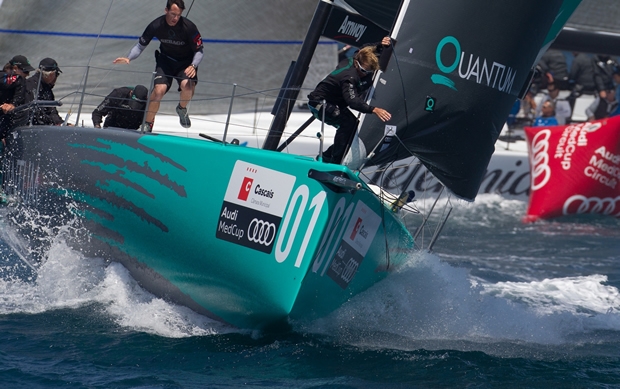
TP52s on the 2011 Audi MedCup
A year ago there were murmurings that the TP52 competition in the Audi MedCup might not survive what with the downturn in the global economy and the likely departure of the Cup teams that represented the majority in fleet racing’s most elite class. Thankfully this has not come to pass and the Audi MedCup season opener this week in Cascais features six brand new boats and one more, Bribon, that is a 2009 generation boat, modified to the latest iteration of the TP52 rule. Granted seven boats, with possibly two more due to join in later in the season, may not be the 24 strong fleet we saw in 2007, but the class is far from dead.
Torbjorn Tornqvist’s Artemis Racing and Emirates Team New Zealand may have departed for the Cup, while Britain’s TeamOrigin is now defunct, but the move to catamarans or the inability of some teams to raise the money to campaign for the 34th America’s Cup in fact has benefitted the Audi MedCup with AC potential challengers Synergy and All4One all continuing in the TP52 class while the Yacht Club Costa Smerelda’s Azzurra team has also joined the party this year. Adding to the influx are also two more powerful teams, Niklas Zennström’s Rán and German Udo Schutz’ Container, both recruits from the Mini-Maxi class.
Others have disappeared such as Cristabella, due to the illness of owner John Cook (touch wood, he intends to return next year, meanwhile Brendan Darrer is running the Rán 72 mini maxi) while the Portugese Bigamist team of Luis Martín Cabiedes and Pedro Mendonça has traded down to the new Soto 40 one design class. Alberto Roemmers’ Argentinian Matador team, that finished third overall last year, returns but in amalgamated form with Azzurra and a new sponsor in Audi. The crew remains predominantly Argentinian with Guillermo Parada on the helm, but with Italian big guns Vasco Vascotto and Francesco Bruni now running the tactical/strategy show on board, and Simon Fry and Paul Westlake trimming.
Two existing TP52s return, albeit with new crews and paintjobs. Jose Cusi’s Bribon team, with whom the King Juan Carlos of Spain occasionally races, has acquired the 2009 Judel-Vrolijk designed Matador, while British interests are being represented by Tony Langley’s Gladiator, formerly the 2009 generation Artemis, although, as Langley told us at the TP52 Worlds last year, he won’t be competing at all the Audi MedCup events this year and isn’t in Cascais.
Both boats have been modified to the new TP52 rules and, early season at least, don’t seem to be off the pace, as Audi MedCup Technical Director Nacho Postigo observes: “The bottom line is that Bribon is very quick and when they were racing at PalmaVela Gladiator was doing well in some races, so it seems there isn’t a huge advantage [of having a new boat]. Maybe they don’t know how to get the maximum out of the new boats yet, but it doesn’t look like if you have a new boat you are definitely the fastest guy on the race track.”
Sadly two additional TP52 campaigns that looked promising earlier this year have fallen by the wayside. The Juan K-designed TeamOrigin boat came close to getting sponsorship, ready to be campaigned by Iain Percy and Andrew Simpson, but this didn’t happen and she has since undergone a severe refit and refairing at Green Marine and will be campaigned by Charles Dunstone’s Rio team. Similarly the Russian Valars team under skipper Sergei Chevstov were due to compete until a key sponsor fell through.
New hardware
Of the six new TP52s, they breakdown into three pairs of boats
- Ràn and Container are both ‘narrow’ Judel Vrolijk designs, built by Green Marine
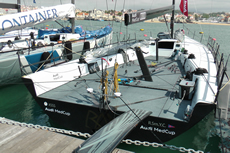 |
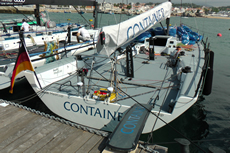 |
- Both Audi-backed boats, Azzurra Sailing Team and All4One are ‘fat’ Judel Vrolijk designs, their sterns looking very VO70-like, Azzurra built by Longitud Zero, All4One by McConaghy
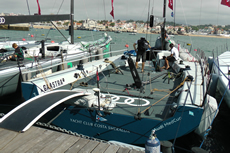 |
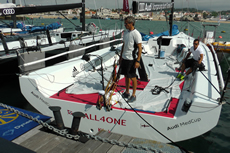 |
- The two Botin Partners (note - no longer Botin & Carkeek) boats, Quantum Racing and Synergy, built by Longitud Zero.
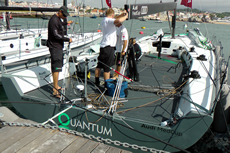 |
Compare these with the 2009 Judel/Vrolijk design...
Rule changes
Over the last two winters, the TP52 fleet has been undergoing a gradual turboing and with a marked increase in keel weight coming into effect for this year, so the majority teams have taken the opportunity to build anew.
The most significant changes to the boats are that the overall weight of a TP52 has dropped marginally from 7600kg to 7300, while the keel package now has a maximum weight of 4800kg of which the bulb shall be no more than 3800kg. This represents an increase in bulb weight of 600-800kg.
Part of the reason for the weight adjustment is that under the old rule some boats were carrying more than 1000kg (or typically 600-1000) of lead correctors in their bilge (some also had solid, rather than cored, laminate around the keel area). Under the new rule lead correctors were expected to be reduce to around 100kg but in fact due to the fastidiousness with which some of the teams have put their new boats together the weight range still has a 300kg variation with the lightest (ie with the most correctors) believed to be Rán and the heaviest believed to be the ‘fat Reichel Pughs’. While there is certainly more hull on Audi Azzurra and Audi All4One, there is also believed to be more structure and certainly in the case of Rán, there have been significant weight savings in the gear being fitted.
As stated in our recent tour of Niklas Zennström’s new Rán, under the new TP52 rule the vertical centre of gravity of the keel package and the rig are now set, while the VCG of the hull is no longer restricted and so this has been under close scrutiny of all the teams, looking to lower hull VCG as much as possible. All manner of cunning ways to do this have been investigated, from reducing freeboard to the minimum and the height of the cockpit sole, to the vertical positioning of winches to lowering the engine and outdrive, to reducing the number of connections in their pedestal-winch drive system. The pit winch has been getting smaller and smaller and now on Container they have got rid of it completely.
Much is probably going on down below on the boats that the likes of us have been unable to see, but most evident from the deck are the cabintop alternatives. With the new rule halving the area down below where there is standing headroom (and this also being reduced) so the Botin boats have a slightly bulbous flush deck while the Judel Vrolijks have been able to lower the deck further but at the expense of keeping the boxy cabin top. The Botin option should have less windage and result in a slightly stiffer boat at the expensive of a slightly high VCG compared to the Vrolijks.
Sail limitations have changed slightly, going up by one sail. TP52s can have 18 sails, or, new for this season, 17 plus two grandfathered sails from the previous season (one more than last year)
Crew weight was changed last season, reduced to 1050kg plus a guest, effectively shedding two crew, which was generally welcomed as previously the boats were considered overstaffed.
According to TP52 Class Secretary Rob Wieland, there will be a meeting of the class at the third Audi MedCup event in Cagliari where they will look at possible rule changes for 2012. This is likely to include making the use of titanium permissible provided they are “standard equipment catalogue items”. They may also add a mandatory sheer radius as due to the lowering of the deck, so the hull to deck join is now becoming sharp and as a result most uncomfortable to hike on.
Nacho Postigo is pleased with how the latest TPs have turned out, being a little quicker, better looking through lower freeboard, an ever diminishing cabintop, the square topped main, bowsprit and big kites and the convergence with IRC. Now with the boats all having to be approved by Germanischer Lloyds , they are structurally more robust, Chris Hosking, who project managed the Rán build saying he’d be happy for his boat to do the Sydney Hobart (something that would have been plain dangerous on some TP52s of five years ago).
“The only complaint I have heard is that they are nobby horsing a bit more than they used to, because of the bigger bulb. I had the same feeling when we were sailing with the guys off Matador on Lola [Alberto Roemmers’ IRC52],” says Postigo.
Back to the hardware
The move to fat boats – and in addition to the Audi boats, the new Quantum and Synergy are also heading in this direction – has been spurred by the success of the Emirates Team NZ boat that won the last two seasons of the Audi MedCup. Adrian Stead reckons the Kiwi boat was 5-6% more stable than their old Quantum Racing, coming into its own upwind in anything over 8 knots.
It should be noted that while Judel-Vrolijk designs have been the most prolific over the last seasons, the Audi MedCup championship winning boats for the last three seasons, since 2008 when Quantum Racing won, have been designs from the Kiwi Cup team’s Principle Designer, Marcelino Botin.
According to Rolf Vrolijk, the rule changes further limiting key aspects of the stability should make the relative performances of the boats closer.
The 2011 Audi MedCup visits the same venues to 2010, only at different times of year, with this season concluding in Barcelona rather than Cagliari, thus the expected wind ranges this season are believed to be reasonably similar to last year. Thus for these, Rolf Vrolijk says that the narrower Ràn/Container style hull shape, which are a development to the new rule of their highly successful 2009 generation Matador (now Bribon), should prove to be the best all-round boats for this year’s circuit. The other boats, as was the case with the Team New Zealand boat, should offer more form stability up the range (the crossover is in theory between 10 and 13 knots, depending upon who you talk to).
“We looked into alternatives where you could have trade-offs between stability and drag, just producing more stability with the hull. There is more performance in that, but you just have to tickle it out of it,” says Vrolijk, who reckons the fatter Audi boats will be strong downwind but also in lighter conditions due to their narrow waterline. “The big gains that Team New Zealand made with their boat are not possible this year because the stability of the boats is so much higher, so it is a different game. The bulb and fin weight has increased by 600-800kg, so the gains you can make with hull stability are smaller than they were last year.”
North Sails guru, Simon Fry, who is the downwind trimmer on Audi Azzurra, explains why they went for the fatter Vrolijk boat. “When we signed up to the concept, we balanced the decision: We have always been relatively strong in the light. Some of that was our previous boat and some was the way we learned to deal with the TP rig and what we could do with it in the light. The view was that if we could take some of that forward and keep some of the light weather performance through good rig tune, good knowledge and then take a gain in the breeze with the hull form we thought that for us as a team that would be an overall benefit.
“In the light one of the things we are definitely going to have to do is be very accurate how we sail the boat with heel angle and fore and trim will be very important. Then the balance on the sail trim side is to make sure we are developing enough power so that when we trip over the side on the drag bucket we are able to flatten off and sail as quickly as we can.”
Fry points out that the new TP52s are not a great eye opener for him as with their bowsprits and added stability, they now behave similarly to IRCed TP52s he has raced regularly back in the UK.
With the new fleet of new generation boats there have been more teething problems than there have been in previous years and in Cascais one gets the impression most of the crews are still on a steep learning curve with their new steeds. Oddly one of the worst affected has been one of the best prepared in Quantum Racing. Some of their training in Valencia had to be cut short when their rudder blade delaminated back into its two separate halves. They had to miss two days of PalmaVela due some significant problems with their mast step and prior to the regatta starting in Cascais they had another issue with the tack for their jib. However given their performance over the last couple of days they seem to have got their boat reliable just in time and the performance of the top Botin designs indicates that they are the quick boats upwind in more than 15 knots of breeze.
At the time of writing four of the seven TP52s had won races in Cascais, including the 2009 generation Bribon, although Quantum has since won three in a row. They may be down in numbers, but the Audi MedCup looks set to be perhaps the most competitive it has ever been.
In action:
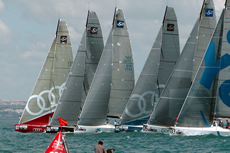 |
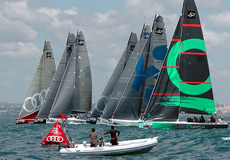 |
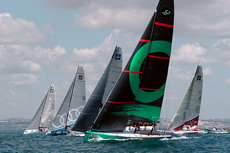 |
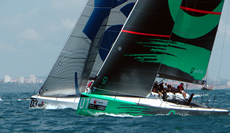 |
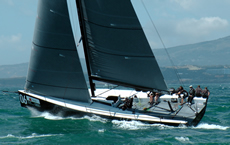 |
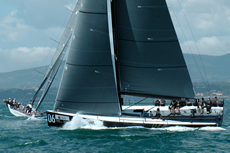 |
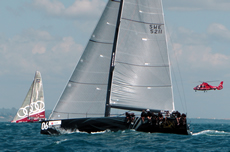 |
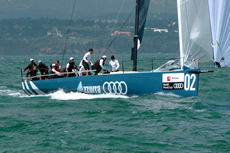 |
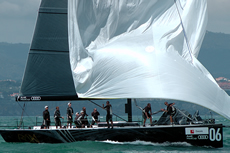 |
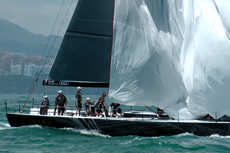 |
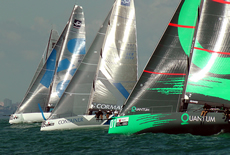 |
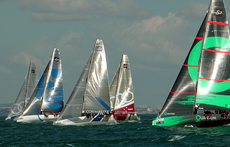 |
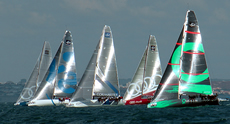 |
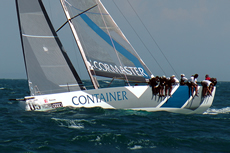 |
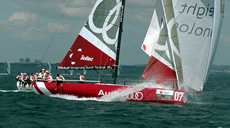 |
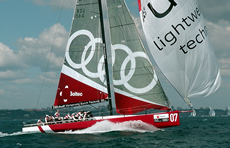 |
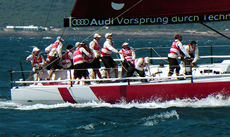 |
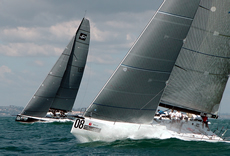 |
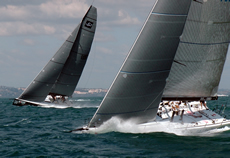 |
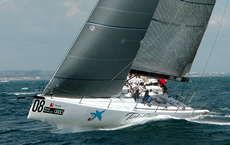 |
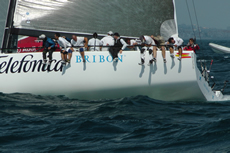 |
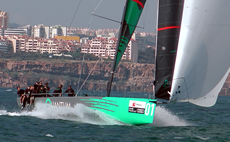 |
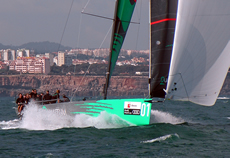 |
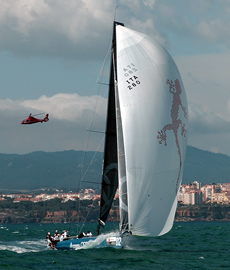 |
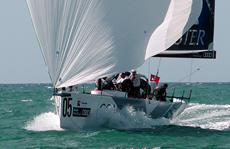 |
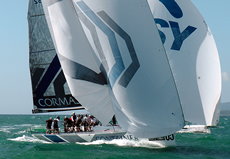 |

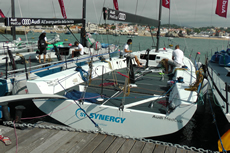
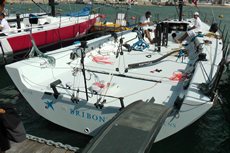









Latest Comments
Add a comment - Members log in